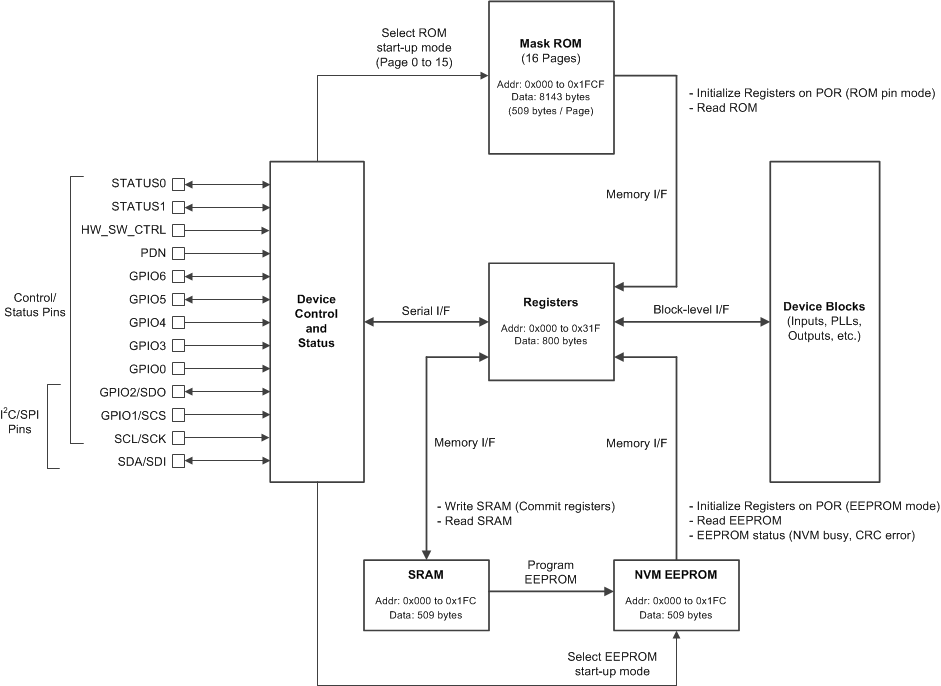SNAS724A February 2018 – April 2018 LMK05028
PRODUCTION DATA.
- 1 Features
- 2 Applications
- 3 Description
- 4 Revision History
- 5 Description (continued)
- 6 Pin Configuration and Functions
- 7 Specifications
- 8 Parameter Measurement Information
-
9 Detailed Description
- 9.1 Overview
- 9.2 Functional Block Diagrams
- 9.3
Feature Description
- 9.3.1 Oscillator Input (XO_P/N)
- 9.3.2 TCXO/OCXO Input (TCXO_IN)
- 9.3.3 Reference Inputs (INx_P/N)
- 9.3.4 Clock Input Interfacing and Termination
- 9.3.5 Reference Input Mux Selection
- 9.3.6 Hitless Switching
- 9.3.7 Gapped Clock Support on Reference Inputs
- 9.3.8 Input Clock and PLL Monitoring, Status, and Interrupts
- 9.3.9
PLL Channels
- 9.3.9.1 PLL Frequency Relationships
- 9.3.9.2 Analog PLL (APLL)
- 9.3.9.3 APLL XO Doubler
- 9.3.9.4 APLL Phase Frequency Detector (PFD) and Charge Pump
- 9.3.9.5 APLL Loop Filter
- 9.3.9.6 APLL Voltage Controlled Oscillator (VCO)
- 9.3.9.7 APLL VCO Post-Dividers (P1, P2)
- 9.3.9.8 APLL Fractional N Divider (N) With SDM
- 9.3.9.9 REF-DPLL Reference Divider (R)
- 9.3.9.10 TCXO/OCXO Input Doubler and M Divider
- 9.3.9.11 TCXO Mux
- 9.3.9.12 REF-DPLL and TCXO-DPLL Time-to-Digital Converter (TDC)
- 9.3.9.13 REF-DPLL and TCXO-DPLL Loop Filter
- 9.3.9.14 REF-DPLL and TCXO-DPLL Feedback Dividers
- 9.3.10 Output Clock Distribution
- 9.3.11 Output Channel Muxes
- 9.3.12 Output Dividers
- 9.3.13 Clock Outputs (OUTx_P/N)
- 9.3.14 Glitchless Output Clock Start-Up
- 9.3.15 Clock Output Interfacing and Termination
- 9.3.16 Output Synchronization (SYNC)
- 9.3.17 Zero-Delay Mode (ZDM) Configuration
- 9.3.18 PLL Cascading With Internal VCO Loopback
- 9.4 Device Functional Modes
- 9.5 Programming
- 9.6 Register Maps
- 10Application and Implementation
- 11Power Supply Recommendations
- 12Layout
- 13Device and Documentation Support
- 14Mechanical, Packaging, and Orderable Information
9.5.1 Interface and Control
A system host device (MCU or FPGA) can use either I2C or SPI to access the register, SRAM, and EEPROM maps. The register and EEPROM map configurations are the same for I2C and SPI. The device can be initialized, controlled, and monitored through register access during normal operation (not hard reset by PDN = 0). Some device features can also be controlled and monitored through the external logic control and status pins.
In the absence of a host, the LMK05028 can self-start from its on-chip EEPROM or ROM page depending on the state of HW_SW_CTRL pin. The EEPROM or ROM page is used to initialize the registers upon device POR. The EEPROM configuration can be custom programmed through the register interface by either I2C or SPI. The ROM configurations are fixed in hardware and cannot be modified.
Figure 60 shows the device control pin, register, and memory interfaces. The arrows refer to the control interface directions between the different blocks.
The register map has 800 data bytes. Some registers (such as status, internal test/diagnostic bit fields) do not need to be written or accessed during device initialization.
The SRAM/EEPROM has one register page with 509 data bytes. The SRAM/EEPROM map has fewer bytes because not all bit fields are mapped from the register space. To program the EEPROM, it is necessary to write the register contents to SRAM (internal register commit or direct write), then Program EEPROM with the register contents from SRAM. The EEPROM cannot be written directly from the registers.
The ROM has sixteen register pages, and each page has 509 data bytes (same as EEPROM). The ROM contents are fixed in hardware and cannot be modified.
 Figure 60. Device Control, Register, and Memory Interfaces
Figure 60. Device Control, Register, and Memory Interfaces